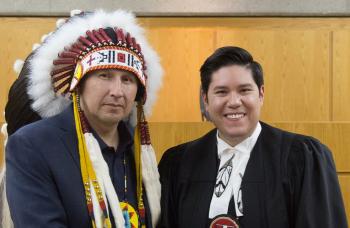Image Caption
By Paula E. Kirman
Windspeaker.com Contributor
Brooks Arcand-Paul (Cree) was admitted to the Alberta Bar on Oct. 27 at the Edmonton Law Courts. While bar admissions happen all the time, this one was unique in that the Office of the Chief Judge provided the opportunity for Arcand-Paul to incorporate elements of his culture into the Call Ceremony.
The ceremony included powwow dancers in traditional regalia, an honour song by Chief Tony Alexis of the Alexis Nakota Sioux Nation, attendance by other chiefs and councillors from the area (Alexander, Ermineskin), the past president of the national Indigenous Bar Association (Koren Lightning-Earle), local Benchers, and members of the legal community.
The Call began with words in Cree and included a smudge. It was held by Judge Ivan Ladouceur, (Métis) judge who presides over the Court in St. Paul, and who is fluent in the language.
“In smudging, I also wanted to highlight a request I made to Judge Ladouceur to invite all of my ancestors and earthly relations to witness the event, so that I will be held accountable for all of the things I do in my career while also celebrating with me in our successes,” said Arcand-Paul, who swore his oath on an eagle feather rather than a Bible. Cheryl Arcand-Kootenay, an Indigenous lawyer with 24 year’s experience, who is also Brooks’ aunt, presented him.
“Throughout my younger days, I saw how successful my aunt was in being a lawyer practicing in family law, and I had an interest in pursuing it from a young age. She was my role model, and I think part of my decision to be a lawyer stemmed from watching her and seeing what went into being a lawyer,” Arcand-Paul said.
He wore some traditional elements fused with the required court attire, including wearing moccasins, beaded tabs, and a medallion made specifically for him.
“The medallion I am wearing was modelled after the National Indigenous Law Students Association by a dear friend of mine, and that association was something I dreamt up and realized through my role as a student representative on the Indigenous Bar Association.”
“The beaded tabs also mean a lot to me, and they were made by my aunt, and are meant to signify the duality of my experiences in the law and walking in both worlds,” Arcand-Paul explained.
Arcand-Paul is the current treasurer with the national Indigenous Bar Association, and currently an associate with the Eagle Law Group based on the Tsuut'ina Nation. Earlier this year he was called to the Law Society of Upper Canada/Ontario Bar and was also permitted to wear some elements of his culture. However, that bar call was done with 200 other candidates, whereas in Alberta bar calls are individual.
Arcand-Paul hopes that he will make an impact in the different aspects of law in which he practises, especially in the Indigenous community.
“The most recent census came out and we are now five per cent of the population, and are growing at four times the national average, and are expected to double our population in the next 20 years. This is huge, and we need advocates to stand up (against) the continued injustices we face today,” he said.
“My practice so far has been in Aboriginal law along with corporate and commercial law, a fusion similar to my experiences of walking in both worlds, and I find that with these numbers my practice is going to only go up from here. I want to make sure that those dreamers who want to achieve what they’ve set their mind to, have someone who will understand where they come from and will help walk them through the processes that can sometimes seem very daunting and unknowable,” he said, adding that he has also practised Environmental Law and hopes to do more in that area over time.
Arcand-Paul also hopes he will be an inspiration to other Indigenous people considering a career in law.
“We need more lawyers and laypeople to fight for those who are struggling in the criminal justice system, the child welfare system, and in every system that discriminates against our people. Warriors come in all shapes, sizes, and careers. Continue to Indigenize every space, because we deserve to be in those spaces and to feel comfortable and home, because, aftr all, this land will always be home to us.”
And, he adds, “always listen to your Kookoms and Mosoms. They are so wise and love you so much.”

